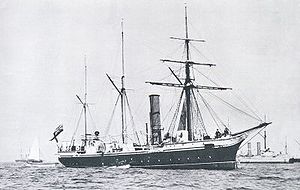Beagle class sloop
 A photograph of HMS Nymphe, visually idential to the Beagle class | |
| Class overview | |
|---|---|
| Name: | Beagle class sloops |
| Operators: | |
| Built: | 1889 |
| In commission: | 1889–1920 |
| Completed: | 2 |
| Lost: | 0 |
| General characteristics | |
| Type: | Screw Steel Sloop |
| Displacement: | 1170 tons[1] |
| Length: | 195 ft (59 m) [2] |
| Beam: | 30 ft (9.1 m) [3] |
| Draught: | 13 ft (4.0 m) [3] |
| Installed power: | 2000 horsepower[4] |
| Propulsion: |
Three-cylinder horizontal triple-expansion steam engine Twin screws |
| Sail plan: | Barquentine rig |
| Endurance: | 3,000 nmi (5,600 km) at 10 kn (19 km/h)[2] |
| Complement: | 138 [2] |
| Armament: |
As built |
| Armour: | Protective deck of 1 in (2.5 cm)-1.5 in (3.8 cm) steel over the machinery and boilers[2] |
The Beagle class was a two-ship class of 8-gun screw steel sloops [5] built for the Royal Navy in 1889.
Contents
Design
Beagle and Basilisk were constructed of copper-sheathed steel to a design by William White, the Royal Navy Director of Naval Construction. They were powered by a twin-screw three-cylinder horizontal triple expansion steam engine developing 2,000 horsepower (1,500 kW) and carried a barquentine sail rig.[2] They were essentially the same design as the preceding Nymphe class, but built of steel rather than of composite wood-and-steel.[2]
Operational Use
In common with other designs of Royal Navy sloop of the period, the Beagle class were not intended or designed to fight a modern fleet action; they were intended to patrol Britains' extensive maritime empire, and this is how they were employed. Beagle conducted three foreign commissions between 1890 and 1900, at least two of which were on the South Atlantic Station.[1] She was refitted in 1900, during which her 5-inch (130 mm) breech-loading guns were replaced with quick-firing guns. Basilisk also spent all or part of her career on the South Atlantic Station. [4]
Ships
| Name | Ship Builder | Launched | Fate |
|---|---|---|---|
| HMS Beagle | Portsmouth Royal Dockyard | 28 February 1889 | Sold to BU on 11 July 1905[1][2][5] |
| HMS Basilisk | Sheerness Royal Dockyard | 6 April 1889 | Became coal hulk C7 and sold as Maggie Grech in 1905[2][4][5] |
References
- ↑ 1.0 1.1 1.2 "HMS Beagle at Naval Database website". http://www.pbenyon.plus.com/18-1900/B/00499.html. Retrieved 2008-08-31.
- ↑ 2.0 2.1 2.2 2.3 2.4 2.5 2.6 2.7 Winfield, Rif; Lyon, David (2003). The Sail and Steam Navy List, 1815-1889. Chatham Publishing. ISBN 978-1861760326.
- ↑ 3.0 3.1 "HMS Basilisk at Battleships-Cruisers website". http://www.battleships-cruisers.co.uk/cruisers.htm. Retrieved 2008-08-31.
- ↑ 4.0 4.1 4.2 "HMS Basilisk at Naval Database website". http://www.pbenyon.plus.com/18-1900/B/00480.html. Retrieved 2008-08-31.
- ↑ 5.0 5.1 5.2 "Naval Sloops at battleships-cruisers.co.uk". http://www.battleships-cruisers.co.uk/naval_sloops_.htm. Retrieved 2008-08-30.
| ||||||||
